| Construction Rating: | starstarstarstarstar |
| Flight Rating: | starstarstarstarstar |
| Overall Rating: | starstarstarstarstar |
| Diameter: | 2.22 inches |
| Length: | 14.40 inches |
| Manufacturer: | Estes  |
| Skill Level: | 2 |
| Style: | Scale |

Brief:
The Estes BLU-97B Cluster Bomb Model Rocket Kit is one of four new Estes "Military" kits recently released; a nice salute to our boys overseas. I purchased the kit on August 11, 2003, as soon as I saw the first ones in the store and had it built and flown by the following weekend. I have to say all four of the new Estes kits are pretty cool, but this cluster bomb with its short, stout look and unique nosecone really caught my attention. Moreover, it comes with four cluster bombs that are ejected at apogee and descend on their own streamers. For these reasons, it just had to be the first one from the group to be built.
Construction:
The kit comes in two styles, a "Launchable" you can find at Wal-Mart or a standard bagged kit you can find at the hobby shops. Both are identical in parts, but I chose to build the bagged version. Included is a BT70 tube, motor mount, retainer, cardstock centering rings, shock cord, parachute, instructions and balsa fins pre-cut for thru-the-wall mounting. Also included are polystyrene halves for both the tailcone and nosecone. The nosecone is a very unique shape so it appears that molding it in halves was a better way to produce it.
This is an 18mm kit that according to the packagin "reaches 390'"...well, I decided to weigh it to see and found that the model came in at a whopping 4.2oz, without glue or paint. I am guessing it would finish at around 6oz, making it pretty heavy for a C6, hence I decided to modify it right out of the box as a 24mm model...this turned out to be a good decision and I was able to make the changes with only an additional 24mm motor mount tube and block; all the other parts remained stock.
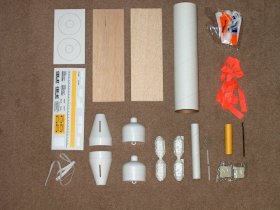
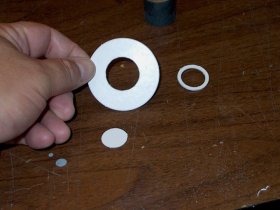
Construction began by modifying the motor mount. I cut a 5" piece of 24mm LOC motor mount tube, then cut the bottom of the tailcone to enlarge it about 1/4" so the mount could pass through. the Estes CR's were opened up to 24mm and I used a coupler tube as an outer sleeve to hold the retainer in place. The retainer was put in a vice and I bent the lip outwards, 1/4" from the tip after it was flattened. The upper retainer tip now pointed toward the outside of the rocket and has to rip thru the CR and 1" long black coupler in order to fail...I also glued in a motor stop inside the motor mount to accommodate the new E9 motors. For smaller 24mm or RMS I can use an adapter.

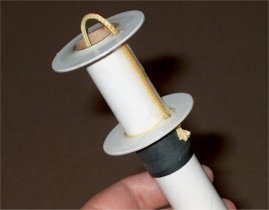
Needless to say the conversion was very easy; five inches of 24mm tube, a 24mm green motor stop and a BT55 coupler to hold the retainer on were all the extra parts needed...all the others were easily modified to make them work. The entire tailcone was assembled using yellow glue, plastic cement and 5 minute epoxy. It was glued into the body tube and the nosecone halves were assembled, then fit to the bodytube. Note that I added an 18" piece of 1/8" tubular Kevlar on the lower motor mount assembly for part of the shock cord assembly...also, the shock cord included in the kit is only about 12" long...WAY too short so I cut a new piece from stock about 30" long and tied it to the Kevlar cord, then covered it with some heat shrink tube.
I managed to resize the fins so they would fit the larger motor mount. The fins are TTW, which is a nice touch for a small model, but they needed shortened in depth since the new motor mount was a larger diameter. I also "dry rubbed" some Elmer's wood filler into the grain on each of the balsa fins. I thought about replacing them with ply or basswood, but decided against it since the supplied balsa is very dense and hard. I fine sanded each fin edge, then mixed up some of that 5 minute clay putty type epoxy I had and used it to fill the gap where the motor mount extends past the tailcone. It made for a nice and smooth transition.


Next I began installing the fins. Five minute epoxy was used and I did two at a time, using a stick to keep them aligned. Once all four fins were done, I sanded the body tube to prep it for launch lugs and primer.
The kit comes with two launch lugs, placed at the bottom and very top of the BT. I placed one at the bottom and one around mid point instead of the top...just a personal preference. As it turned out, the bottom of the upper lug is where CG is, a nice locator if questioned. Additionally, I cut two pieces of scrap 3/32" balsa from the fins 1/8" wide and the length of each lug. The lug was mounted to each balsa "spacer" using Alphaetic Resin. I also used epoxy for actually mounting the lugs to the BT.
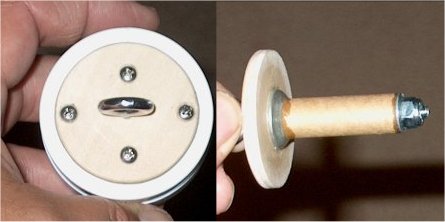 I also finished the nosecone assembly. I cut a 1/2" hole in the back of the plastic nosecone, then laminated a plate from two 3/32" pieces of Basswood, glued cross-grained for strength. I installed a 2 1/2" long x 3/16" Eyebolt and coated the inside nut and washer with 5-minute epoxy. A BT20 Coupler was slid over the bolt and glued in place. I mixed up and poured in some West Systems 205 Epoxy into the tube, then poured in some Lead Shot on top of it. West Systems was used since it is thin and allowed the shot to sink to the bottom. I capped it with a washer and nylon locking nut. The assembly was fitted into the lightweight nosecone, then I drilled and countersunk four holes and used #4 screws to retain the plate to the back of the nosecone.
I also finished the nosecone assembly. I cut a 1/2" hole in the back of the plastic nosecone, then laminated a plate from two 3/32" pieces of Basswood, glued cross-grained for strength. I installed a 2 1/2" long x 3/16" Eyebolt and coated the inside nut and washer with 5-minute epoxy. A BT20 Coupler was slid over the bolt and glued in place. I mixed up and poured in some West Systems 205 Epoxy into the tube, then poured in some Lead Shot on top of it. West Systems was used since it is thin and allowed the shot to sink to the bottom. I capped it with a washer and nylon locking nut. The assembly was fitted into the lightweight nosecone, then I drilled and countersunk four holes and used #4 screws to retain the plate to the back of the nosecone.
I used 5 minute epoxy for small fillets, then spent some time sanding each fillet and I applied a few coats of white base Primer. Once it dried, I added several coats of Gray Primer and it was left to dry overnight. I wetsanded the nosecone and Bodytube with 320 Grit and it came out pretty smooth. Both the Bodytube and Nosecone were primed once again with the final coats of white primer, which will make a good base for the olive drab green paint. Painting always takes a while...Prime...wait a day, Sand, Prime, wait more, etc...

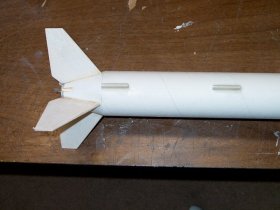
Note, the stock nosecone is .5oz and the clay is .5oz, totaling 1.0 ounce for the stock setup. My nosecone with lead shot is 2oz...giving me that added margin of stability. Also, with the extra weight, it may no longer be able to fly on a C6...something I was thinking of long before I modified it and I took this extra weight into consideration when upgrading it to a 24mm mount. As a final touch, the parachute was upgraded to a 18" Estes, then after a few flights were made, I upgraded again to an 18" nylon chute.

Finishing:
I wound up using olive drab Testors paint and it covered the Krylon primer very well. Three coats were applied, then I let it sit for three days before masking. I masked off the nosecone tip and painted it with two coats of Testors chrome spray paint. It covered perfect and dried fast. I removed the masking then spent time on the Bodytube. Decals for the model are peel and stick, which look pretty good, but be careful as a few were not cut all the way through. The model was finished and I waited a couple days for the Chrome to dry before applying Dullcoat to seal the model and protect/flat out the decals.
Construction Rating: 5 out of 5
Flight:
Launch day came and I was pretty excited. I prepped the model with a C11-3 for it's first flight. I still use tissue wadding for that nostalgic effect and packed it, then rolled each cluster bomb streamer and placed them over the wadding. Come to find out, the cluster bombs act as an additional shield to prevent melting of the parachute. Next the shock cord and parachute was packed and nosecone installed. The model weighed in at 6.4oz dry, so we were looking at a near 8oz flight. The model was placed on the pad and the countdown was on. It lifted aggressively off the pad, very cool looking, and reached about 100'. The flight was straight and flawless, even with some wind. Obviously nosecone weight was right on.
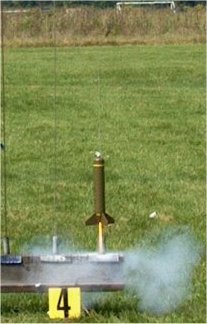 Recovery:
Recovery:
The model arced over and ejected just slightly down, a good effect for the cluster bombs which released along with the chute. The 18" parachute was a good choice, allowing the model to descend gently back to the ground. The cluster bombs came in and all landed within a 10' circle, right next to the model. It was a great flight. Next, I launched it several times on a D12 and once more on a C11. Each time it flew flawlessly and only one bomb was lost to the high weeds. What a great day of flying.
Since the first flights in mid August, I have put over 30 flights on the Cluster Bomb. It has flown on C11-3, D12-3, E9-4 and E18W-4 motors multiple times. The E18 White Lightning flight is awesome!!! Picture a model just over a foot long with a flame longer than the rocket! I wound up depleting my entire stock of E18's, nine flights in all and need to restock again. Moreover, the little bird is stout enough even with balsa fins, to handle the E18 and more...I think the TTW (thru-the-wall) fin mounts make a difference here.
Flight Rating: 5 out of 5
Summary:
In summary, the BLU-97B Cluster Bomb Model Rocket Kit from Estes is one very unique model and a great flier! I highly recommend this rocket to everyone, but do recommend you do the motor mount upgrade. With that said, you will wind up with what I feel is one of the best kits Estes has made to date, The BLU-97B Cluster Bomb!
FYI, at printing of this review, I have just completed the construction of an upscale version of this kit. It is 77" tall, 12.75" in diameter, weighs in at around 30lbs and is capable of flying on K-M motors...look for a review on it soon as it is in it's finishing stage.
Overall Rating: 5 out of 5
Other Reviews
- Estes BLU-97B Cluster Bomb By Max Handly
This is Estes new 1:6.4 scale BLU-97B Cluster Bomb. The rocket is fat (2.25") and short (14"). It comes with 4 "cluster bombs" which are small, about 1.5 inches long that get ejected at deployment and streamer to the ground. The kit contains: one body tube two part nose cone (cut in half) two part tail cone (with through the tube slots!) die-cut balsa fins bomblets ...
- Estes BLU-97B Cluster Bomb By Steve Kristal
Brief: I was doing a rocket launch for Science Day at my kids' school. Since the field was small, I wanted something slow and low. Since the spectators were young, I wanted "something special" and I thought the "spits out nerdlets on streamers" factor would be a big plus. Since I wouldn't have time to reload between classes I knew I would have to build 6 rockets of each type I was launching (the ...
 |
 |
Flights
Sponsored Ads
 |
 |











